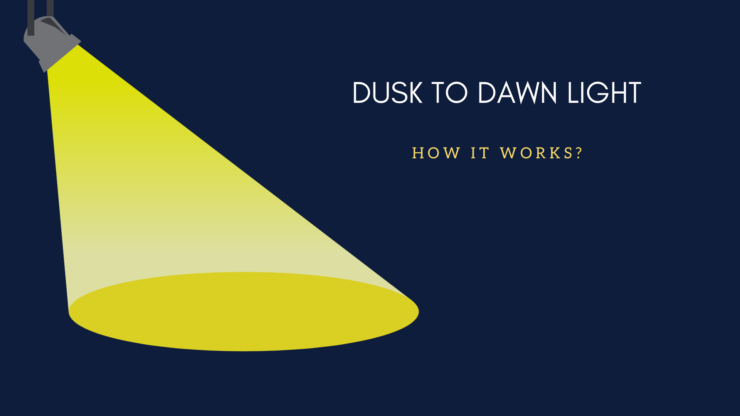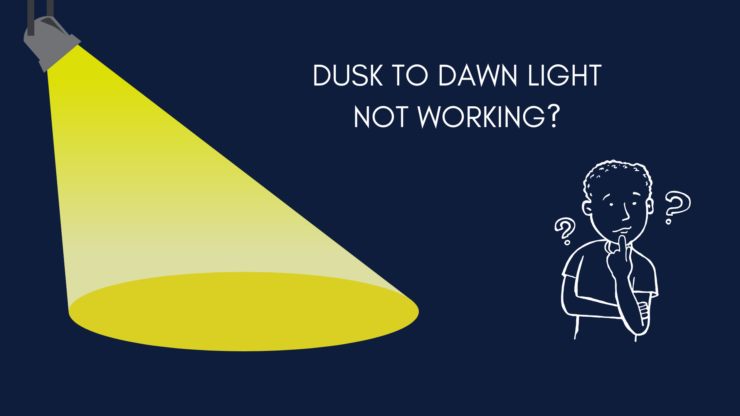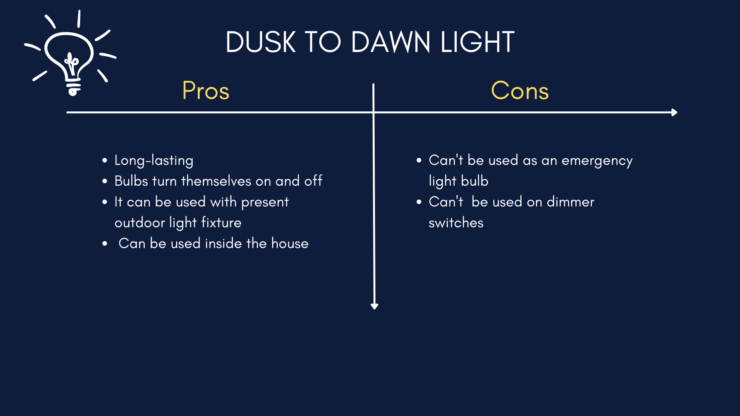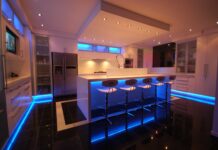Would you like to come home at night to a well-lit environment? Or, would you like to have your lights coming on and off when the need arises? So you need to know the common dusk to dawn light troubleshooting.
If you answered yes to any of these questions, you’ll love dusk-to-dawn lights.
- Skill Level: Beginner to Intermediate. This electrical project is best performed by a Licensed Electrician or Electrical Contractor
- Tools Required: Basic Hand Tools and Safe Ladder
- Estimated Time: Depends on personal experience, the light fixture and access to the light fixture.
The main reason Dusk to Dawn lights don’t turn on or stay on is that the sensor is frozen in the on or off position. The lights may also be turning off frequently at night because the sensors are detecting the light from other sources or from the lights themselves. If the lights are controlled by a timer, the timer may become out of sync due to Daylight Savings or other reasons.
They are fast becoming popular for many good reasons. The inbuilt sensors are designed to detect when the sun goes up or down.
This means you’ll never have to worry about switching your light on/off. It does that for by itself.
In this article, we’ll uncover everything you need to know about dusk to dawn light troubleshooting, maintenance tips, and much more.
What Is Dusk To Dawn Light?
As the name implies, a dusk to dawn light comes on at sunset, stays on, and goes off at sunrise.
They come in different sizes and are best used for illuminating the exterior of your home. For more help with the exterior of your home be sure to check homeanalyst.net.
They are used for:
- Security reasons: it provides light sufficient enough to see when an intruder comes in.
- Easy to use: you never have to remember to switch it on/off.
- Convenience: you can walk around your home conveniently even at nights.
How Does Dusk to Dawn Light Work?

Photocells are what tells the lighting system when to come on and when to go off. Although photocells are of different types, they have one basic principle — Semiconductors. All photocells use semiconductors to control current.
Here is how it works — when a certain amount of light hits the semiconductors, current flows. This action causes the lighting system to go off. The current flow stops as the light goes dim.
This action triggers the lighting system to come on. Now, some photocell sensors let you decide the level of light that can activate the photocell. If you do not own a dusk-to-dawn lighting system, you can convert your existing fixture into one.
All you need is to get a photocell that can be screwed into bulb sockets. Install the photocell into individual sockets and that’s all. Photocells can be replaced or used together with time and motion sensors. Time sensors come on and off at specific times. This type of sensor is not dependent on environmental factors. Motion sensors, on the other hand, react to motion. When it senses movement, it comes on. Whatever kind of sensor you use should depend on your need.
Read about Lighting a Living Room Without Overhead Lighting Decoration.
Common Dusk to Dawn Light Troubleshooting & Solutions

You may experience some glitches while using the dusk to dawn lights. Here are some common problems, their causes and how to solve them.
1. Light Won’t Come On
When your light doesn’t come on, it could be as a result of an incorrect lamp or ballast. To fix this, check your lamp type and compare it to the label on the fixture. Ensure that the ANSI numbers of lamps and ballast correlate.
Loose wiring may also be a reason why your lights refuse to come on. To solve this issue, disconnect the fixture from the power supply and check the wiring connections.
It could also be the lamp has been damaged. Replacing the old lamp with a new one will solve this problem. Some lamps become dark when they are damaged. Others like the Mercury and Metal Halide lamps give very low light output. To replace your damaged lamp, switch off its power supply. This will help prevent electric shocks and other electrical hazards.
Unscrew the old lamp and screw in the new.
2. Short Lamp Life
This could be a result of using an incorrect lamp or ballast. Always check your lamp type and ensure it matches the label on the fixture.
Short lamp life could also be as a result of a faulty lamp. Simply replace the damaged lamp with a new one.
3. The Lamp Keeps Blowing Up
This could be as a result of using an incompatible lamp type or insert.
A great way to avoid this problem is to ensure that your insert is compatible with your light fixtures.
4. The Lamp Goes On And Off
This could be as a result of fluctuating voltage. To fix this, check your voltage supply.
It could also be as a result of a Faulty insulation detector.
5. Lowered Light Output
Lowered light output can be as a result of a damaged or faulty lamp. The best fix for this is to replace the bulb with a new one.
6. Erratic or Slow Lighting
This could be as a result of a hard-starting lamp. If the delay is unbearable, change the lamp.
Your ballast may also be faulty and need replacement. Test ballast and replace as the need arises.
Loose or wrong wiring also leads to slow lighting. To solve this issue, unplug from the power source and re-check wiring connections.
Also, check to see if the lamp and Ballast ANSI numbers match. Another major cause of erratic or slow lighting is fluctuating voltage.
Use a voltmeter to measure the incoming voltage and make sure it is enough to power the bulb.
7. Flickering bulb
Loose connections can lead to flickering bulbs. Always make sure your connections are intact. This can also be caused by faulty bulbs. This can be fixed by replacing the faulty bulb.
Very low ambient temperature can cause flickering bulbs. To fix this, check the ambient temperature. If it’s below 50°F, change to a ballast that is designed for such a condition.
This can also be caused by air movement across the lamp. Always make sure that there are no fans or any air conditioning systems blowing across the lamp. If you go through all this and there is still no improvement, then a faulty switch may be the cause.
Now that we know some of the common problems affecting dusk to dawn light bulbs, let us now look at how you can choose the right one.
Pros and Cons of Dusk to Dawn Light Bulbs

- They are long-lasting
- Dusk to dawn bulbs turn themselves on and off
- It can be used with your present outdoor light fixture.
- You don’t need to bother about switching them on or off.
- May be used inside the house.
- These light bulbs cannot be used as an emergency light bulb.
- They cannot be used on dimmer switches
The Basic Construction of Dust to Dawn Light
The dusk-to-dawn light consists of four major components:
- Power source: this is where power is generated.
- Switch: you can turn the lights on/off here.
- Photocell: this is what detects when the sun is gone down. It then triggers the bulb to come on.
- Bulb: this is what emits light.
Connect these four components correctly, and you will have a simple but powerful lighting system.
How To Choose a Dusk to Dawn Lights
When choosing dusk to dawn light, you need to put some factors into consideration.
Here are some tips to help you make the right decision.
What Would You Like To Achieve With The Light Bulb?
Before choosing dusk to dawn bulb, establish why you are purchasing it. Most people use them as outdoor security lights, while some others use them as indoor lights.
The bulb used for outdoor purposes is likely to be much brighter than that meant for our interior.
Once you have made up your mind, go ahead and purchase what suits you.
Take The Bulb’s Wattage And Lumens Into Consideration
Wattage refers to the amount of energy required to generate a certain amount of light. So, a higher wattage gives you brighter light.
Lumens, on the other hand, is the amount of energy a bulb gives out.
Although it consumes more energy. If you need to know how bright a bulb is, look out for lumens.
What Color Would You Prefer
There are a lot of colors you can choose from. Some of the colors include ‘warm white’, ‘soft white’, and ‘cool white’.
Other available colors are purple, red, yellow, and many more.
Even if you like a particular color, choose one that will perfectly fit its location. A soft white light may be all you need to keep your home lit.
- Warm White – light emitted has a yellowish color and is quite similar to the traditional bulb.
- It is a great choice for outdoor security purposes.
- Cool White – Emits cooler light and has a bluish color. It is also great as outdoor lighting.
- Soft White – this falls somewhere between ‘warm white’ and ‘cool white’.
Maintenance Tips
You do not need to invite an electrician to maintain your lighting system. You can follow these simple DIY maintenance tips. To maintain your dusk-to-dawn light, you may need to clean the fixture periodically.
To do this, use a non-abrasive, gentle glass cleaner and a soft cloth. Gently remove dirt, dust, and particles from its surface.
You may also need to change bulbs as the need arises. To do this, switch off the light.
Wait for the fixture to cool off (if it’s hot). Gently unscrew the existing bulb and replace it with a new one.
Do’s & Don’ts
As with any other electrical system, the dusk-to-dawn light has its set of dos and don’ts. Here they are:
- Switch off power supply when cleaning the dust-to-dawn light fixture.
- Do NOT use a glass cleaner or solvent that contains abrasives or harsh ingredients.
- Do not use your cleaner directly on the bulb, wiring, or socket.
- Do not service lighting fixtures without disconnecting its power supply.
FAQ’s of Dust To Dawn Lights

How Do You Reset A Dusk To Dawn Light?
Resetting dusk to dawn light is quite a simple task. First of all, turn off the lights (using the light switch).
The second step, leave it off for about a second. Lastly, flip the light switch back on.
That’s all you need to do to reset your dusk to dawn lights.
How Do You Know If Your Photocell Is Bad?
It’s simple. Try to cover the photocell and prevent light from hitting it. When you do this, a functional photocell should read ‘0’.
Next, remove the cover and flash a light unto its surface. A functional photocell should read about “1020.”
If the photocells don’t read correctly, it could be because the wires are shorted. Should this be the case, replace the photocell.
What Causes Dusk To Dawn Light To Go Off And On?
There are several reasons why this happens. It may be that you have the wrong bulb.
Fix a new bulb to see if that fixes the issue. If not, your sensor may be getting hot thereby resulting in thermal shutdown.
A third reason could be that your sensor is getting a reflection that triggers the lights to go on and off.
To fix that, look around to see what light reflection is triggering the photosensors. Identify it and remove it.
How Long Do Dusk To Dawn Lights Last?
Dusk to dawn lights, also known as security lights, are outdoor lighting fixtures that are designed to automatically turn on at dusk and turn off at dawn.
The lifespan of dusk to dawn lights can vary depending on several factors, including the quality of the fixture and the type of bulb used.
In general, the average lifespan of a dusk to dawn light bulb is around 10,000 hours, or approximately 3 years if the light is used for 8 hours a day.
However, the lifespan can vary widely depending on the quality of the bulb and how often it is used.
LED bulbs are a popular choice for dusk to dawn lights due to their energy efficiency and long lifespan.
They can last up to 50,000 hours or more, which can translate to over 10 years of use.
Do Dusk To Dawn Lights Use A Lot Of Electricity?
Dusk to dawn lights, also known as security lights, can vary in their electricity usage depending on several factors, including the type of bulb used and the wattage of the fixture.
In general, traditional incandescent bulbs used in dusk to dawn lights are the least energy-efficient and can use a significant amount of electricity.
A 100-watt incandescent bulb, for example, can use up to 1 kilowatt-hour (kWh) of electricity for every 10 hours of use.
However, many modern dusk to dawn lights now use more energy-efficient LED (Light Emitting Diode) bulbs, which can significantly reduce electricity usage.
LED bulbs use up to 80% less energy than incandescent bulbs and can last much longer.
Can dusk-to-dawn lights deter thieves?
Yes, dusk to dawn lights can be an effective deterrent against thieves and burglars.
The automatic lighting can create the illusion that someone is home and can make it more difficult for thieves to approach your home undetected.
Studies have shown that homes with outdoor lighting, including dusk to dawn lights, are less likely to be targeted by burglars than homes without any outdoor lighting.
Additionally, the use of motion sensor lights can be even more effective at deterring burglars, as the sudden activation of the lights can startle and discourage them from attempting to break in.
Common problems with photocells?
One common problem that affects photocell functioning is incorrect or loose wiring between the photocell and the main circuitry of the lighting system.
The wire that connects the photocell to the lighting circuit needs to have a solid, soldered connection. In addition, the system needs to have proper electrical power. Verify that all connections are securely fastened to he power supply.
Verdict
Dusk-to-dawn lights are a breath of fresh air. Since the lights only come on when the sun goes down, it saves energy.
So, if you need an energy-saving, inexpensive, and easy-to-maintain lighting system, the dusk-to-dawn light is the way to go.




